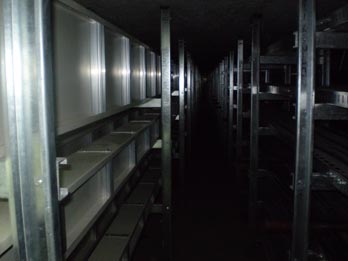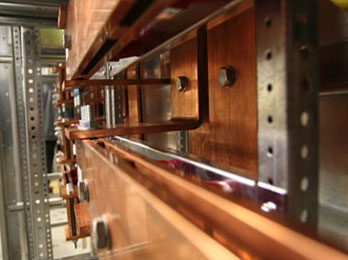12,082 views

Guide To Low Voltage Busbar Trunking Systems
Modern electrical desdign and installations are often placing increasing demands on all products of the electrical equipment manufacturer.
Products must have:
• Reliable service life
• Adaptability to new requirements
• Low installation costs
• Low maintenance costs
• Inherent safety features
• Minimal purchase cost
• Energy efficiency
.
In today’s market one of the most important elements is cost effectiveness. In an electrical installation, one area where savings can be made and provide the features listed above is in the use of busbar trunking systems. Busbar trunking installations can be categorised into two basic types:
- Distribution
- Feeder
Distribution Feeder
This is the most common use of busbar trunking and is applied to distribute power over a predetermined area. Busbar trunking can be run vertically or horizontally, or a combination of both. Typical applications would be:
- Supply to large numbers of light fittings
- Power distribution around factories and offices
- Rising main in office blocks or apartment blocks to supply distribution boards serving individual floors.
Power is taken from busbar trunking by the use of tap off units which connect at defined positions along the busbar trunking, and allow power to be taken from the system, usually via a suitable protective device.
Advantages over cable:
- The contractor can achieve savings with respect to material i.e. cable trays and multiple fixings and also labour costs associated with multiple runs of cable.
- Reduced installation time since busbar trunking requires less fixings per metre run than cable.
- Multiple tap-off outlets allow flexibility to accommodate changes in power requirements subsequent to the initial installation (subject to the rating of the busbar trunking).
- Repositioning of distribution outlets is simpler
- System is easily extendable.
- Engineered product with proven performance.
- Type tested to recognised international and national standards.
- Aesthetically pleasing in areas of high visibility.
Feeder Trunking
When used for the interconnection between switchboards or switchboard and transformer, busbar trunking systems are more economical to use, particularly for the higher current ratings, where multiple single core cables are used to achieve the current rating and compliance with voltage drop and voltage dip requirements.
Beside this, bunch of cables are increasing possiblity of heating between cables and eventually short circuit.
.
Advantages over cable:
- Greater mechanical strength over long runs with minimal fixings resulting in shorter installation times.
- Replaces multiple runs of cable with their associated supporting metalwork.
- Easier to install compared to multiples of large cables with all of the associated handling problems.
- Less termination space required in switchboards.
- Type tested short circuit fault ratings.
- Takes up less overall space, bends and offsets can be installed in a much smaller area than the equivalent cable space.
- Cable jointer not required.
- Busbar trunking systems may be dismantled and re-used in other areas
- Busbar trunking systems provide a better resistance to the spread of fire.
- Voltage drop and voltage dip in the majority of cases is lower than the equivalent cable arrangement.

- Typical Busbar Layout
Tap-Off Units
Tap-off units are of two types, either plug-in or fixed. Plug-in units are designed to be accommodated at tap-off outlets at intervals along the distribution busbar trunking. Fixed tap-off outlets are engineered and positioned during manufacture to suit the specified installation. The tap-off unit usually contains the device providing protection to the outgoing circuit terminated at the unit to distribute power to the required load.
There are various types of protective devices, for example:
1. HRC fuses to BS EN 60269-1 (BS88)
2. Miniature Circuit Breakers to BS EN 60898
3. Moulded Case Circuit Breakers to BS EN 60947-2
HRC fuses may be incorporated into fuse combination units to BS EN 60947-3. The degree of enclosure protection of the tap-off unit is defined by BS EN 60529.
Each tap-off unit contains the necessary safety features for systems and personnel protection, as follows:
- Plug-in units are arranged to be non-reversible to ensure that they can only be connected to give the correct phase rotation.
- Plug-in units are arranged to connect the protective circuit before the live conductors during installation and disconnect the protective circuit after the live conductors while being removed.
- Where units are provided with a switch disconnector or circuit-breaker these are capable of being locked in the OFF position.
- Covers permitting access to live parts can only be removed by the use of a tool and will have any internally exposed live parts shielded to a minimum of IP2X or IPXXB in accordance with BS EN 60529.
- Outgoing connection is achieved by cable terminations in the unit or by socket outlets to BS EN 60309-2 or BS 1363.
Fire Stops
Recommendations for the construction of fire-stops and barriers where trunking penetrates walls and floors classified as fire barriers. Internally the trunking may or may not require fire-stop measures according to the construction; where they are required these will generally be factory-fitted by the manufacturer and positioned according to a schematic drawing for the installation. Compact or sandwich-type trunking does not require internal fire-barriers, as suitability as a fire-barrier is inherent in the design.
However in all cases verification of the performance of the trunking under fire conditions needs to be provided by the manufacturer.
The following information is provided for guidance, and the method used should be agreed with the trunking manufacturer. It is not the responsibility of the trunking manufacturer to provide the specification or detail the rating or construction of the fire-stop external to the trunking.
Protective Earth Condustor Sizes
The sealing external to the busbar trunking (with or without an internal fire barrier) will need to conform to applicable building regulations. This may require filling the aperture around the busbar trunking with material to maintain the same fire proofing as the wall or floor.
Careful consideration needs to be given to the access required to complete the fire- stop. It may be necessary to install sections of fire-stop at the stage of installation of the trunking if access afterwards is impossible e.g. trunking runs in close proximity.
The protective earth connection(s) to the busbar trunking system shall conform to Section 543-01 of BS 7671 (IEE Wiring Regulations Sixteenth Edition).
Low-Noise Earth Systems
A low-noise earth, commonly referred to as a ‘clean earth’, is typically specified when electronic apparatus supplied from the system is sensitive to spurious voltages arising on the system earth. This is particularly true with IT equipment, found in all commercial premises these days, where data processing functions can be corrupted.
The low-noise earth is provided by a conductor separated from the protective earth (PE) and from all extraneous earth paths throughout the distribution system.
Many busbar trunking systems provide a ‘clean earth’ conductor in addition to the three phase conductors plus neutral, using the case or an external conductor as PE.
Tap-off units must be specified as ‘clean earth’ for the circuits concerned since the separation of the earths must be maintained and an additional termination will be provided for the load circuit ‘clean earth’ conductor. Sizing of the ‘clean earth’ conductor is not specified in BS 7671 (IEE Wiring Regulations Sixteenth Edition) but the usual practice is to calculate the size in the same way as for the protective earth conductor.
Neutral Sizes/Harmonics
The designer of the electrical network specifies the size of the neutral conductor depending upon the network loading. Typically this tends to be a neutral conductor the same size as the phase conductors (i.e.100% neutral). As a minimum a 50% neutral may be specified.
The BS 7671 (IEE Wiring Regulations Sixteenth Edition) states “In a discharge lighting circuit and polyphase circuits where the harmonic content of the phase currents is greater than 10% of the fundamental current, the neutral conductor shall have a cross-sectional area not less than that of the phase conductor(s).”
With the increase of non-linear (almost anything electronic) single phase loads connected to a network, for example electronic ballasts in lighting fittings, or switch-mode power supplies (the type found in personal computers and servers) the total harmonic distortion is increased.
.
Related articles
Posted by ecsanyi on Saturday, April 17, 2010 at 10:22 pm
Filed under Low Voltage, Technical Articles · Tagged with busbar trunking, busways, clontrolgear, distribution feeder, fire stops, guide, harmonics, Low Voltage, plug-in, protective earth, raising main, switchboard, tap-off, transformer
15,276 views

Busbar Technical Specification
Copper busbars are normally part of a larger generation or transmission system. The continuous rating of the main components such as generators, transformers, rectifiers, etc., therefore determine the nominal current carried by the busbars but in most power systems a one to four second short-circuit current has to be accommodated.
The value of these currents is calculated from the inductive reactances of the power system components and gives rise to different maximum short-circuit currents in the various system sections.
.
Performance under Short-circuit Conditions
Busbar trunking systems to BS EN 60439-2 are designed to withstand the effects of short-circuit currents resulting from a fault at any load point in the system, e.g. at a tap off point or at the end of a feeder run.
.
Rating under Short-circuit Conditions
The withstand ability will be expressed in one or more of the following ways:
- short-time withstand rating (current and time)
- peak current withstand rating
- conditional short-circuit rating when protected by a short-circuit protective device (s.c.p.d.)
These ratings are explained in more detail:
1. Short-time Withstand Rating
This is an expression of the value of rms current that the system can withstand for a specified period of time without being adversely affected such as to prevent further service. Typically the period of time associated with a short-circuit fault current will be 1 second, however, other time periods may be applicable.
The rated value of current may be anywhere from about 10kA up to 50kA or more according to the construction and thermal rating of the system.
2. Peak Current Withstand Rating
This defines the peak current, occurring virtually instantaneously, that the system can withstand, this being the value that exerts the maximum stress on the supporting insulation.
In an A.C. system rated in terms of short-time withstand current the peak current rating must be at least equal to the peak current produced by the natural asymmetry occurring at the initiation of a fault current in an inductive circuit. This peak is dependent on the power-factor of the circuit under fault conditions and can exceed the value of the steady state fault current by a factor of up to 2.2 times.
3. Conditional Short-circuit Rating
Short-circuit protective devices (s.c.p.ds) are commonly current-limiting devices; that is they are able to respond to a fault current within the first few milliseconds and prevent the current rising to its prospective peak value. This applies to HRC fuses and many circuit breakers in the instantaneous tripping mode. Advantage is taken of these current limiting properties in the rating of busbar trunking for high prospective fault levels. The condition is that the specified s.c.p.d. (fuse or circuit breaker) is installed up stream of the trunking. Each of the ratings above takes into account the two major effects of a fault current, these being heat and electromagnetic force.
The heating effect needs to be limited to avoid damage to supporting insulation. The electromagnetic effect produces forces between the busbars which stress the supporting mechanical structure, including vibrational forces on A.C. The only way to verify the quoted ratings satisfactorily is by means of type tests to the British Standard.
.
Type Testing
Busbar trunking systems are tested in accordance with BS EN 60439-2 to establish one or more of the short circuit withstand ratings defined above. In the case of short-time rating the specified current is applied for the quoted time. A separate test may be required to establish the peak withstand current if the quoted value is not obtained during the short-time test. In the case of a conditional rating with a specified s.c.p.d. the test is conducted with the full prospective current value at the trunking feeder unit and not less than 105% rated voltage, since the s.c.p.d. (fuse or circuit breaker) will be voltage dependent in terms of let through energy.
.
Application
It is necessary for the system designer to determine the prospective fault current at every relevant point in the installation by calculation, measurement or based on information provided e.g. by the supply authority. The method for this is well established, in general terms being the source voltage divided by the circuit impedance to each point. The designer will then select protective devices at each point where a circuit change occurs e.g. between a feeder and a distribution run of a lower current rating. The device selected must operate within the limits of the busbar trunking short-circuit withstand.
The time delay settings of any circuit breaker must be within the specified short time quoted for the prospective fault current. Any s.c.p.d. used against a conditional short-circuit rating must have energy limitation not exceeding that of the quoted s.c.p.d. For preference the s.c.p.d. recommended by the trunking manufacturer should be used.
.
Voltage Drop
The requirements for voltage-drop are given in BS 7671: Regulation 525-01-02. For busbar trunking systems the method of calculating voltage drop is given in BS EN 60439-2 from which the following guidance notes have been prepared.
Voltage Drop
Figures for voltage drop for busbar trunking systems are given in the manufacturer’s literature.
The figures are expressed in volts or milli-volts per metre or 100 metres, allowing a simple calculation for a given length of run.
The figures are usually given as line-to-line voltage drop for a 3 phase balanced load.
The figures take into account resistance to joints and temperature of conductors and assume the system is fully loaded.
Standard Data
BS EN 60439-2 requires the manufacturer to provide the following data for the purposes of calculation, where necessary:
R20 the mean ohmic resistance of the system, unloaded, at 20ºC per metre per phase
X the mean reactance of the system, per metre per phase
For systems rated over 630A:
RT the mean ohmic resistance when loaded at rated current per metre per phase
Application
In general the voltage drop figures provided by the manufacturer are used directly to establish the total voltage drop on a given system; however this will give a pessimistic result in the majority of cases.
Where a more precise calculation is required (e.g. for a very long run or where the voltage level is more critical) advantage may be taken of the basic data to obtain a more exact figure.
- Resistance – the actual current is usually lower than the rated current and hence the resistance of the conductors will be lower due to the reduced operating temperature.
.
Rx = R20 [1+0.004(Tc - 20)] ohms/metre and Tc is approximately Ta + Trwhere Rx is the actual conductor resistance
Ta is the ambient temperature
Tr is the full load temperature rise in ºC (assume say 55ºC)
- Power factor – the load power factor will influence the voltage drop according to the resistance and reactance of the busbar trunking itself.
The voltage drop line-to-line ( Δv) is calculated as follows:Δv = √ 3 I (R x cos Φ + X sin Φ) volts/metre
where I is the load current
Rx is the actual conductor resistance (Ω/m)
X is the conductor reactance (Ω/m)
Cos Φ is the load power factor
sin Φ = sin (cos-1 Φ )
- Distributed Load – where the load is tapped off the busbar trunking along its length this may also be taken into account by calculating the voltage drop for each section. As a rule of thumb the full load voltage drop may be divided by 2 to give the approximate voltage drop at the end of a system with distributed load.
. - Frequency – the manufacturers data will generally give reactance (X) at 50Hz for mains supply in the UK. At any other frequency the reactance should be re-calculated.
.
Xf = x F/50
.
where Xf is the reactance at frequency F in Hz
.
Source: Siemens Barduct Busbar Specification
.
Related articles
Posted by ecsanyi on Tuesday, March 9, 2010 at 8:00 pm
Filed under Low Voltage, Technical Articles · Tagged with busbar, busbar trunking, distributed load, en 60439-2, fault current, frequency, insulation, peak current, Power factor, reactance, resistance, rms, short circuit, type testing, voltage drop, withstand rating





